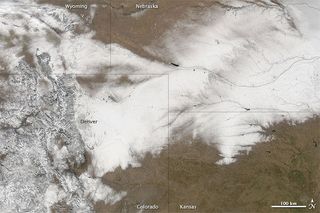
Colorado's Record-Breaking Snow Seen from Space

From NASA's Earth Observatory:
A record-breaking snowstorm struck Colorado in early February 2012, closing an interstate highway, grounding flights, and dropping more than a foot of snow on the Denver area. After moving out of northeastern Colorado, the storm left heavy snow across Nebraska.
The Moderate Resolution Imaging Spectroradiometer (MODIS) on NASA’s Aqua satellite captured this natural-color image on February 5, after skies had largely cleared over the region. Snow and mountain peaks create a mottled appearance in western Colorado. Elsewhere, the snow cover forms a wide, uneven track over parts of Wyoming, Colorado, Kansas, and Nebraska.
This snowfall did not break all-time records in Colorado, but it did break records for the month of February. The National Weather Service explained that northeastern Colorado generally experiences storms of this magnitude in March or April, and the February storm showed some of the same characteristics of powerful spring storms, including a system from the Pacific Northwest converging with moisture from the Gulf of Mexico. The storm set a new record for the heaviest storm snowfall for February, depositing 15.9 inches (40.4 centimeters) in Denver, and 22.7 inches (57.7 centimeters) in Boulder.
Colorado ski resorts welcomed the precipitation after suffering from below-normal snow cover so far in the 2011–2012 ski season, but the new snow raised the risk of avalanches. As of February 6, the Colorado Avalanche Information Center reported “considerable” avalanche danger across much of the state.
Heavy snow was not limited to Colorado. The National Weather Service reported up to 18 inches (46 centimeters) of snow west of Omaha, Nebraska.
Sign up for the Live Science daily newsletter now
Get the world’s most fascinating discoveries delivered straight to your inbox.

